Статьи журнала - International Journal of Intelligent Systems and Applications
Все статьи: 1126
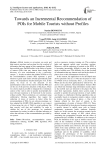
Towards an incremental recommendation of POIs for mobile tourists without profiles
Статья научная
Mobile tourism or m-tourism can assist and help tourists anywhere and anytime face the overload of information that may appear in their smartphones. Indeed, these mobile users find difficulties in the choice of points of interest (POIs) that may interest them during their discovery of a new environment (a city, a university campus ...). In order to reduce the number of POIs to visit, the recommendation systems (RS) represent a good solution to guide each tourist towards personalized paths close to his instantaneous location during his visit. In this article, we focus on (1) the detection of the spatiotemporal context of the tourist to filter the POIs and (2) the use of the previous notations of the places. These two criteria make it possible to integrate the evolutionary context of the visit in order to predict incrementally the most relevant transitions to be borrowed by the tourists without profile. These predictions are calculated using collaborative filtering algorithms that require the collection of traces of tourists to better refine the recommendation of POIs. In our software prototype, we have adapted the SLOPE ONE algorithm to our context of discovering the city of Chlef to avoid problems like data scarcity, cold start and scalability. In order to validate the use of this prototype, we conducted experiments by tourists in order to calculate indicators to assess the relevance of the recommendations provided by our system.
Бесплатно
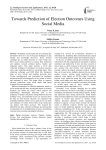
Towards prediction of election outcomes using social media
Статья научная
Exploiting social media data by extracting key information from it is one of the great challenges in data mining and knowledge discovery. Every election campaign has an online presence of voters which uses these social media platform to express their sentiments and opinions towards political parties, leaders and important topics. This paper presents a novel data collection technique for prediction of election outcomes and a topic modeling method for extracting topics. Data collection technique used RSS (Rich Site Summary) feeds of news articles and trending keywords from Twitter simultaneously and constructed an intelligent prediction model based primarily on the volume of tweets and sentiment of users. This paper effort to improve electoral predictions using social media data based dynamic keyword methodology. Different techniques for electoral prediction based on social media data has been investigated based on existing literature and isolate the factors which improve our methodology. Meaningful inferences such as the popularity of leaders and parties during different intervals, trending issues, and important factors are extracted from the data set. The election outcomes are compared with traditional methods used by survey agencies for exit polls and validation of results showed that social media data can predict with better accuracy. The research has identified that data collection technique and timing play an important role in yielding better accuracy in predicting outcomes and extracting meaningful inferences.
Бесплатно
Track Processing Approach for Bearing-Only Target Tracking
Статья научная
This paper mainly studies angle-measurement based track processing approach to overcome the existing problems in the applications of traditional approaches for bearing-only target locating and tracking system. First, this paper gives suited data association algorithms including track initiation and point-track association. Moreover, a new tracking filtering association gate method is presented through analysis of the target motion characteristics in polar coordinates for improving bearing-only measurement confirming efficiency of real target and limiting false track overextension with the dense clutter. Then, by analyzing the feasibility of using multi-model technology, the IMM is adopt as filtering algorithm to solve existing problem in bearing-only tracking for complicated target motion in two dimensional angle plane. As the results, the two dimensional bearing-only tracking accuracy of real target is improved and false tracking is greatly limited. Moreover, computation cost of IMM is analyzed in view of the real-time demand of bearing-only tracking. Finally, this paper gives some concrete summary of multi-model choosing principle. The application of the proposed approach in a simulation system proves its effectiveness and practicability.
Бесплатно
Tracking Power Photovoltaic System using Artificial Neural Network Control Strategy
Статья научная
Photovoltaic generation is the technique which uses photovoltaic cell to convert solar energy to electric energy. Nowadays, PV generation is developing increasingly fast as a renewable energy source. However, the disadvantage is that PV generation is intermittent because it depends considerably on weather conditions. This paper proposes an intelligent control method for the maximum power point tracking (MPPT) of a photovoltaic system under variable temperature and solar irradiation conditions. In this paper, a simulation study of the maximum power point tracking (MPPT) for a photovoltaic system using an artificial neural network is presented. The system simulation is elaborated by combining the models established of solar PV module and a DC/DC Boost converter. Finally performance comparison between artificial neural network controller and Perturb and Observe method has been carried out which has shown the effectiveness of artificial neural networks controller to draw much energy and fast response against change in working conditions.
Бесплатно
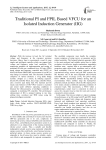
Traditional PI and FPIL based VFCU for an isolated induction generator (IIG)
Статья научная
With the increase in load, the AC terminal voltage and frequency at the consumer premises decreases. Hence, there is encountered a need of some simple and intelligent controller which can support both voltage and frequency under load conditions. This manuscript emphasis on implementation and testing of traditional PI and non- traditional fuzzy PI logic (FPIL) based voltage and frequency controller unit (VFCU) in MATLAB based SIMULINK environment for an IIG for step change in consumer load. The electronic Controller comprises of various elements: a 3-leg diode bridge rectifier, chopper as a switch, dc filtering capacitor, discrete PI controller block, fuzzy logic controller block, and a resistive type dump load. The transient and the steady state behavior of IIG-VFCU system is examined and tested under different operating conditions to illustrate the efficaciousness of intelligent controller as compared to traditional PI controller. The performance enhancement of IIG is attained relating to rise time, settling time, overshoot and THD values using the planned intelligent controller.
Бесплатно
Trajectory Tracking of Linear Inverted Pendulum Using Integral Sliding Mode Control
Статья научная
This paper considers the trajectory tracking control of linear inverted pendulum (IP) system. First the linearized model of IP is derived to facilitate the control design. To avoid non robust reaching phase, integral sliding mode control (ISMC) has been proposed but single variable case is tested. Linear IP is a multivariable system having angle of pendulum and position of cart are two variables to be controlled. In control design, the LQR control is designed as a nominal control to get the desired trajectory. Then discontinuous control using integral sliding mode(ISM) is introduced to get desired trajectory tracking in the presence of uncertainties. This control is robust to the model uncertainties and disturbances during entire motion of the states. The simulation results are presented to show the effectiveness of proposed control scheme. The results are compared with LQR control to show the integral sliding mode control is having better tracking performance in the presence of uncertainties.
Бесплатно
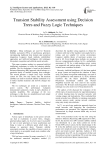
Transient Stability Assessment using Decision Trees and Fuzzy Logic Techniques
Статья научная
Many techniques are used for Transient Stability assessment (TSA) of synchronous generators encompassing traditional time domain state numerical integration, Lyapunov based methods, probabilistic approaches and Artificial Intelligence (AI) techniques like pattern recognition and artificial neural networks. This paper examines another two proposed artificial intelligence techniques to tackle the transient stability problem. The first technique is based on the Inductive Inference Reasoning (IIR) approach which belongs to a particular family of machine learning from examples. The second presents a simple fuzzy logic classifier system for TSA. Not only steady state but transient attributes are used for transient stability estimation so as to reflect machine dynamics and network changes due to faults. The two techniques are tested on a standard test power system. The performance evaluation demonstrated satisfactory results in early detection of machine instability. The advantage of the two techniques is that they are straightforward and simple for on-line implementation.
Бесплатно
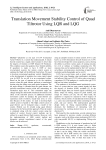
Translation movement stability control of quad tiltrotor using LQR and LQG
Статья научная
Quadrotor as one type of UAV (Unmanned Aerial Vehicle) is a system that underactuated. It means that the system has a signal control amount is lower than the degrees of freedom or DOF (Degree Of Freedom). This condition causes the quadrotor have limited mobility. If quadrotor is made to have 6 DOF or more (overactuated system), the motion control system to optimise the flight will be different from before. We need to develop overactuated quadrotor control. Quadtiltrotor as the development of quadrotor has some control signal over its DOF. So we call it as an overactuated system. Based on the type of manoeuvre to do, the transition process when the quad tiltrotor performs a translational motion using the tilting rotor need special treatment. The tilt angle change is intended that the quad tiltrotor can perform translational motion while still maintaining its orientation angle near 0°. This orientation angle can change during the undesirable rotational movement as the effect of the transition process. If additional rotational movements cannot be damped, the quad tiltrotor can experience multi overshoot, steady-state error, or even fall. Because of this matter, we need to develop flight control system to handle it. The flight control system of quad tiltrotor can be designed using a model of the system. Models can be created using quad tiltrotor dynamics by the Newton-Euler approach. Then the model is simulated along with the control system using the method of control. Several control methods can be utilised in a quad tiltrotor flight systems. However, with the implementation of LQG control method and Integrator, optimal translational control of the quad tiltrotor can be achieved.
Бесплатно
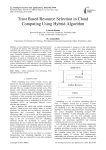
Trust Based Resource Selection in Cloud Computing Using Hybrid Algorithm
Статья научная
Cloud computing is experiencing rapid advancement in academia and industry. This technology offers distributed, virtualized and elastic resources as utilities for end users and can support full recognition of “computing as a utility” in the future. Scheduling distributes resources among parties which simultaneously and asynchronously seek it. Scheduling algorithms are meant for scheduling and they reduce resource starvation ensuring fairness among those using resources. Most Task-scheduling cloud computing procedures consider task resource requirements for CPU and memory, and not bandwidth. This study suggests optimizing scheduling with BAT-Harmony search hybrid algorithm.
Бесплатно
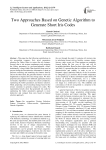
Two Approaches Based on Genetic Algorithm to Generate Short Iris Codes
Статья научная
This paper has the following contributions in iris recognition compass: first, novel parameters selection for Gabor filters to extract the iris features. Second, due to iris textures randomness and assigning the Gabor parameters by pre-knowledgeable values, traditionally, a large Gabor filter bank has been used to prevent losing the discriminative information. It leads to perform extracting and matching the features heavily and on the other hand, the generated feature vectors are lengthened as required for extra storage space. We have proposed and compared two different approaches based on Genetic Algorithm to reduce the system complexity: optimizing the Gabor parameters and feature selection. Third, proposing a novel encoding strategy based on the texture variations to generate compact iris codes. The experimental results show that generated iris codes by optimizing the Gabor parameters approach is more distinctive and compact than ones based on feature selection approach.
Бесплатно
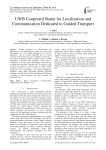
UWB Cooperatif Radar for Localization and Communication Dedicated to Guided Transport
Статья научная
Wireless technology for communication and localization in train applications are widely used. Ultra wide band appears as a very suitable technology for this kind of application, due to its large bandwidth, also to its good resistance to the interference and to multipath. In this paper, a new system dedicated to railway transport, based on UWB technology is presented. The originality of this study is combination of the two main functionalities, localization and communication providing a high data rate. The sensor, in order to detect the position of vehicles, uses a matched digital correlation receiver. To allow a multi user access and to combine the two functionalities, two original multiplexing techniques called SSS2 (Sequential Spreading Spectrum technique) and CPM (Code Position Modulation) are performed, in addition to other parameters like used waveform and orthogonal codes.
Бесплатно
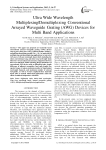
Статья научная
This paper has proposed new materials based conventional arrayed waveguide grating (AWG) devices such as pure silica glass (SiO2), Lithium niobate (LiNbO3) , and gallium aluminum arsenide (Ga(1-x)Al(x)As) materials for multiplexing and demultiplexing applications in interval of 1.45 μm to 1.65 μm wavelength band, which including the short, conventional, long, and ultra long wavelength band. Moreover we have taken into account a comparison between these new materials within operating design parameters of conventional AWG devices such as diffraction order, length difference of adjacent waveguides, focal path length, free spectral range or region, maximum number of input/output wavelength channels, and maximum number of arrayed waveguides. As well as we have employed these materials based AWG to include Multi band applications under the effect of ambient temperature variations.
Бесплатно
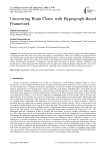
Uncovering Brain Chaos with Hypergraph-Based Framework
Статья научная
The scientist has proven that the birth of neurons in a region of adult rat brain migrates from their birthplace to other parts of the brain. The same process also happens in adult humans. There was no efficient visualization tool to view the functions and structures of the human brain. In this paper, we focus to design a framework to understand more about Alzheimer’s disease and its process of neurons in the human brain. This framework named a hypergraph-based neuron reconstruction framework. It helped to map, the birth and death of neurons with the construction and reconstruction of the hypergraph. This framework also recognizes the structural changes during the life cycle of the neuron. Its performance was evaluated quantitatively with small-world networks and robust connectivity measures.
Бесплатно
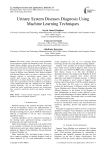
Urinary System Diseases Diagnosis Using Machine Learning Techniques
Статья научная
The urinary system is the organ system responsible for the production, storage and elimination of urine. This system includes kidneys, bladder, ureters and urethra. It represents the major system which filters the blood and any imbalance of this organ can increases the rate of being infected with diseases. The aim of this paper is to evaluate the performance of different variants of Support Vector Machines and k-Nearest Neighbor with different distances and try to achieve a satisfactory rate of diagnosis (infected or non-infected urinary system). We consider both diseases that affect the urinary system: inflammation of urinary bladder and nephritis of renal pelvis origin. Our experimentation will be conducted on the database “Acute Inflammations Data Set” obtained from UCI Machine Learning Repository. We use the following measures to evaluate the results: classification accuracy rate, classification time, sensitivity, specificity, positive and negative predictive values.
Бесплатно
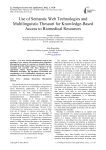
Статья научная
For more relevant informational retrieval and matching of user request with metadata about biomedical informational recourses it is necessary to formulize the user knowledge about this subject domain. We propose to use the ontologies and associated with them thesauri of the appropriate subject domains for representation of biomedicine knowledge. The algorithms of formation and normalization of the multilinguistic thesauruses, and also methods of their comparison are given in this work.
Бесплатно
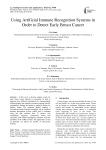
Using Artificial Immune Recognition Systems in Order to Detect Early Breast Cancer
Статья научная
In this work, a decision support system for early breast cancer detection is presented. In hard to diagnose cases, different examinations (i.e. mammography, ultrasonography and magnetic resonance imaging) provide contradictory findings and patient is guided to biopsy for definite results. The proposed method employs a Correlation Feature Selection procedure and an Artificial Immune Recognition System (AIRS) and is evaluated using real data collected from 53 subjects with contradictory diagnoses. Comparative results with commonly used artificial intelligence classifiers verify the suitability of the AIRS classifier. The application of such an approach can reduce the number of unnecessary biopsies.
Бесплатно
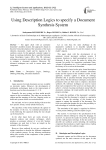
Using Description Logics to specify a Document Synthesis System
Статья научная
This paper deals with an automatic document’s synthesis system. Our approach is based on the prior formal description of the semantics of the main elements (document, reader and his request) in the synthesis system. In this approach, semantic capture is based on ontology definition that is specified formally using Description Logics (DL). The DL inference techniques associated to production rules are then used to compute a document synthesis. Moreover, DL inference techniques are used to reason about each component.
Бесплатно
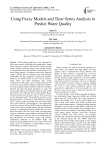
Using Fuzzy Models and Time Series Analysis to Predict Water Quality
Статья научная
Water quality prediction is very important for both water resource scheduling and management. Simple linear regression analysis and artificial neural network models cannot accurately forecast water quality because of complicated linear and nonlinear relationships in the water quality dataset. An adaptive neuro-fuzzy inference system (ANFIS) that can integrate linear and nonlinear relationships has been proposed to address the problem. However, the ANFIS model can only work in scenarios where input and target parameters have strong correlations. In this paper, a fuzzy model integrated with a time series data analysis method is proposed to address the water quality prediction problem when the correlation between the input and target parameters is weak. The water quality datasets collected from the Las Vegas Wash between the years 2005 and 2010, and the Boulder Basin, Nevada-Arizona from the years 2011 to 2016 are used to test the proposed model. The prediction accuracy of the proposed model is measured by three different statistical indices: mean average percentage error, root mean square error, and coefficient of determination. The experimental results have proven that the ANFIS model combined with a time series analysis method achieves the best prediction accuracy for predicting electrical conductivity and total dissolved solids in the Las Vegas Wash, with the testing value of coefficient of determination reaching 0.999 and 0.997, respectively. The fuzzy time series analysis has the best performance for dissolved oxygen and electrical conductivity prediction in the Boulder Basin, and dissolved oxygen prediction in the Las Vegas Wash, with testing value of coefficients of determination equal to 0.990, 90975, and 0.960, respectively.
Бесплатно
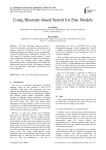
Using Heuristic-based Search for Zinc Models
Статья научная
The Zinc modelling language provides a rich set of constraints, data structures and expressions to support high-level modelling. Zinc is the only modelling language that supports all solving techniques: constraint programming, mathematical methods, and local search. By providing search patterns, it allows users to implement their search methods in a declarative way. There are currently three search patterns implemented in Zinc: backtracking search, branch and bound search, and local search. In this paper we explain how Zinc efficiently implements user-defined local search algorithms.
Бесплатно
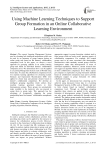
Статья научная
The current Learning Management Systems used in e-learning lack intelligent mechanisms which can be used by an instructor to group learners during an online group task based on the learners' collaboration competence level. In this paper, we discuss a novel approach for grouping students in an online learning group task based on individual learners' collaboration competence level. We demonstrate how it can be applied in a Learning Management System such as Moodle using forum data. To create the collaboration competence levels, two machine learning algorithms for clustering namely Skmeans and Expectation Maximization (EM) were applied to cluster data and generate clusters based on learner's collaboration competence. We develop an intelligent grouping algorithm which utilizes these machine learning generated clusters to form heterogeneous groups. These groups are automatically made available to the instructor who can proceed to assign them to group tasks. This approach has the advantage of dynamically changing the group membership based on learners' collaboration competence level.
Бесплатно

